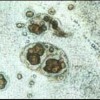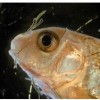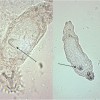 After many years of diagnostics at the University of Florida and at other laboratories around the country, it appears that Cryptobia iubilans is not uncommon among cichlids, and that environmental and other factors determine the extent of disease.This 3-page fact sheet was written by Ruth Francis-Floyd and Roy Yanong, and published by the UF Department of Fisheries and Aquatic Sciences, September 2014.
After many years of diagnostics at the University of Florida and at other laboratories around the country, it appears that Cryptobia iubilans is not uncommon among cichlids, and that environmental and other factors determine the extent of disease.This 3-page fact sheet was written by Ruth Francis-Floyd and Roy Yanong, and published by the UF Department of Fisheries and Aquatic Sciences, September 2014.
http://edis.ifas.ufl.edu/vm077
Tag: Fish Parasites
Lernaea (Anchorworm) Infestations in Fish (FA185)
 Lernaea species, commonly known as “anchorworms,” are crustacean, copepod parasites that can infect and cause disease and mortality in many types of freshwater fishes, especially wild-caught and pond-raised species. Infestations with Lernaea are most prevalent in the summer months and occur more commonly in stagnant or slow-moving water bodies. This 4-page fact sheet was written by Natalie Steckler and Roy P. E. Yanong, and published by the UF Department of Fisheries and Aquatic Sciences, December 2012.
Lernaea species, commonly known as “anchorworms,” are crustacean, copepod parasites that can infect and cause disease and mortality in many types of freshwater fishes, especially wild-caught and pond-raised species. Infestations with Lernaea are most prevalent in the summer months and occur more commonly in stagnant or slow-moving water bodies. This 4-page fact sheet was written by Natalie Steckler and Roy P. E. Yanong, and published by the UF Department of Fisheries and Aquatic Sciences, December 2012.
http://edis.ifas.ufl.edu/fa185
Argulus (Fish Louse) Infections in Fish (FA184)
 Argulus species (Family: Argulidae), more commonly known as fish lice, are members of a large group of branchiuran parasites that infest and cause disease in fish. The argulids are crustaceans and are related to crabs, lobsters, and shrimp. This 5-page fact sheet was written by Natalie Steckler and Roy P. E. Yanong, and published by the UF Department of Fisheries and Aquatic Sciences, November 2013.
Argulus species (Family: Argulidae), more commonly known as fish lice, are members of a large group of branchiuran parasites that infest and cause disease in fish. The argulids are crustaceans and are related to crabs, lobsters, and shrimp. This 5-page fact sheet was written by Natalie Steckler and Roy P. E. Yanong, and published by the UF Department of Fisheries and Aquatic Sciences, November 2013.
http://edis.ifas.ufl.edu/fa184
Common Monogenean Parasites of Fishes (FA28/FA033)
 Monogeneans are a class of parasitic flatworms that are commonly found on fishes and lower aquatic invertebrates. Most monogeneans are browsers that move about freely on the fish’s body surface feeding on mucus and epithelial cells of the skin and gills; however, a few adult monogeneans will remain permanently attached to a single site on the host. Some monogenean species invade the rectal cavity, ureter, body cavity, and even the blood vascular system. Between 4,000 and 5,000 species of monogeneans have been described. They are found on fishes in fresh and salt water and in a wide range of water temperatures. This 10-page fact sheet was written by Peggy Reed, Ruth Francis-Floyd, and RuthEllen Klinger, and published by the UF Department of Fisheries and Aquatic Sciences, June 2012.
Monogeneans are a class of parasitic flatworms that are commonly found on fishes and lower aquatic invertebrates. Most monogeneans are browsers that move about freely on the fish’s body surface feeding on mucus and epithelial cells of the skin and gills; however, a few adult monogeneans will remain permanently attached to a single site on the host. Some monogenean species invade the rectal cavity, ureter, body cavity, and even the blood vascular system. Between 4,000 and 5,000 species of monogeneans have been described. They are found on fishes in fresh and salt water and in a wide range of water temperatures. This 10-page fact sheet was written by Peggy Reed, Ruth Francis-Floyd, and RuthEllen Klinger, and published by the UF Department of Fisheries and Aquatic Sciences, June 2012.
http://edis.ifas.ufl.edu/fa033